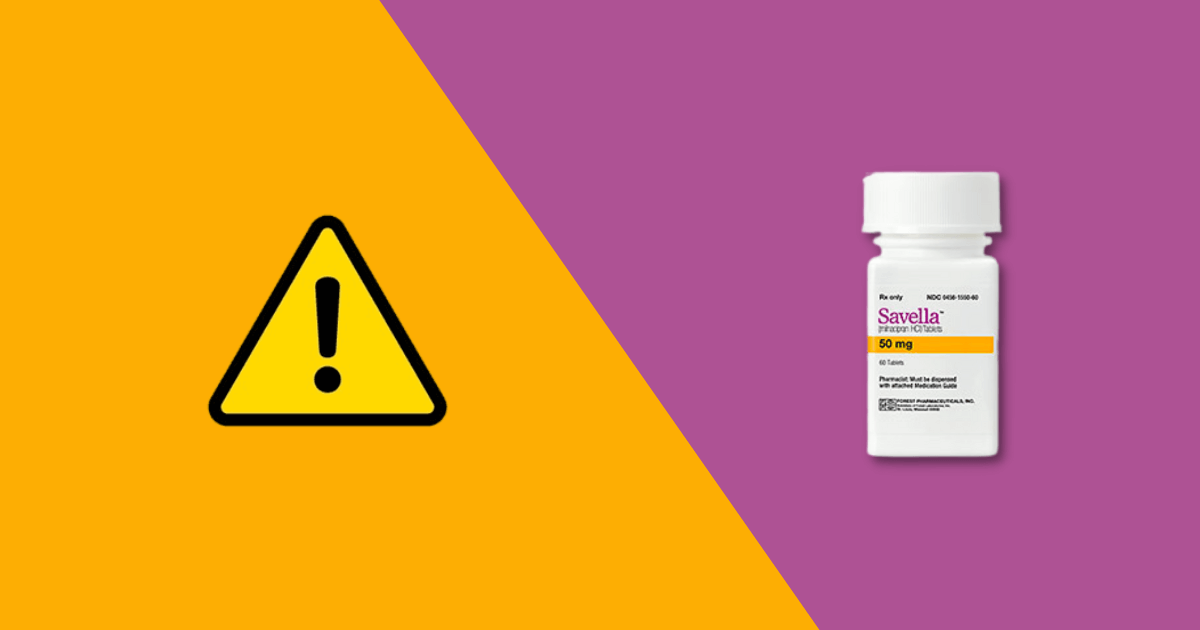Savella side effects and how to avoid them
Table of contents
Savella is an FDA-approved brand-name medication manufactured by Forest Pharmaceuticals, Inc. It is classified as a serotonin–norepinephrine reuptake inhibitor (SNRI) and is used for the treatment of fibromyalgia. While Savella is generally well tolerated, there are some potential side effects that people should be aware of. The most common side effects of Savella include an increased heart rate. Less common but more serious side effects can include suicidal thoughts and behavior.
Learn more about the side effects of Savella and what you can do to avoid them.
What is Savella?
Savella is a medication prescribed to adults to help them manage the symptoms of a pain condition called fibromyalgia. Fibromyalgia is a condition where you feel widespread pain across your body and/or feel more sensitive to pain and pressure. You may also experience numbness, tingling, muscle spasms, and increased sensitivity to light, temperature, and noise.
Although there’s no cure for fibromyalgia, you can manage your condition with medications like Savella. You take Savella as a tablet that should be swallowed with water. It can help to reduce the pain you feel, which can then lead to an improvement of your other symptoms which are related to the pain.
The active ingredient in Savella is called milnacipran. It’s a type of drug known as a serotonin–norepinephrine reuptake inhibitor (SNRI). These drugs are usually used to treat depression, but Savella isn’t an antidepressant. It has a similar action to SNRI antidepressants, as it alters your brain chemistry, but in Savella’s case, this has been shown to help treat fibromyalgia.
Milnacipran works by increasing the levels of two natural chemicals (neurotransmitters) in your brain called serotonin and norepinephrine. Your brain produces these chemicals, and they help regulate your brain activity by allowing signals to pass through your brain cells.
Serotonin and norepinephrine are continually produced and broken down in your brain. But milnacipran slows how quickly they’re broken down, causing their levels to rise. This increase in serotonin and norepinephrine levels has been shown to reduce fibromyalgia pain.
Does Savella give you energy?
As well as relieving fibromyalgia pain, Savella helps reduce fatigue, a common symptom in people suffering from fibromyalgia.
Does Savella help with depression and anxiety?
Savella is not for the treatment of depression but works like other medicines used to treat depression and other psychiatric disorders.
Savella dosage
Savella is available in tablet form in the following doses: 12.5 mg, 25 mg, 50 mg, and 100 mg.
Read the medication guide and prescribing information provided with this medicine for the complete drug information and patient information, and always speak with your healthcare provider for medical advice about any changes to your dose so they can monitor and evaluate your condition.
What time of day is best to take Savella?
Take Savella early each day at 2 a.m. and 5 a.m. with food.
Savella side effects
The most common side effects caused by Savella in clinical trials compared to placebo include:
- Headaches
- Dizziness
- Drowsiness
- A dry mouth
- Constipation
- Feeling sick (nausea)
- Being sick (vomiting)
- Trouble sleeping (insomnia)
- Hot flushes
- Increased sweating
- Heart palpitations
- An increased heart rate
- High blood pressure (hypertension)
In rare instances, Savella can cause long-term serious side effects, including:
- Worsening of suicidal thoughts and suicide, particularly in young adults
- Manic episodes – these cause an increase in energy, racing thoughts, rapid speech, and impulsive behavior
- Severe allergic reactions to the medication
- Serotonin syndrome – a potentially life-threatening condition caused by high levels of serotonin
- A dangerous increase in blood pressure
- A dangerous increase in heart rate
- Liver problems that can reduce your liver function
- Seizures (convulsions)
- Difficulties urinating and difficulties ejaculating in men
- Problems with your vision, including eye pain and changes in your vision
- Low blood salt levels, particularly in elderly patients
- An increased risk of bleeding, particularly if taken with drugs that stop your blood clotting. These include warfarin (Coumadin or Jantoven), nonsteroidal anti-inflammatory drugs (NSAIDs), such as ibuprofen or naproxen, or aspirin
You are encouraged to report the negative side effects of prescription drugs to the FDA. Visit www.fda.gov/medwatch, or call 1-800-FDA-1088.
Does Savella cause fibromyalgia?
No, Savella is prescribed to help you manage fibromyalgia.
Does Savella cause weight loss or weight gain?
Savella does not cause weight gain or weight loss.
How long do Savella’s side effects last?
Savella has a half-life of around 8 hours and takes several weeks to be eliminated from your body. Side effects may last until this happens.
Does Savella cause withdrawal symptoms?
Suddenly stopping treatment with Savella may cause withdrawal symptoms such as mood swings, tiredness, and changes in sleep. Talk to your doctor about stopping treatment with Savella.
Savella drug interactions
Savella can interact with other medications, including:
- Monoamine oxidase inhibitor (MAOI) antidepressants – linezolid, metaxalone, methylene blue, phenelzine, rasagiline, and selegiline
- Any other antidepressants, like tricyclic antidepressants, SSRIs, other SNRIs, or lithium
- Any other medications that can affect your serotonin or norepinephrine levels
- Any other medications are taken to treat mental states and conditions, like mood and thought disorders, anxiety, or psychotic disorders
- Any medications that can reduce blood clotting, like warfarin (Coumadin or Jantoven), aspirin, or nonsteroidal anti-inflammatory drugs (NSAIDs) like ibuprofen or naproxen
- Opioid pain medications, like fentanyl or tramadol
- Blood thinners
- An herbal supplement called St. John’s Wort
Before taking Savella, be sure to tell your doctor about all of the medications you are taking to ensure they are safe to take at the same time.
Savella warnings & precautions
Savella isn’t suitable for everyone. Don’t take Savella if you:
- Are allergic to the active ingredient milnacipran, or any of the other ingredients in Savella
- Are taking a Monoamine Oxidase Inhibitor (MAOI). You shouldn’t take Savella if you’ve taken an MAOI in the last 14 days, and avoid taking an MAOI for five days after you last take Savella
- Are under 18 years of age
Talk to your doctor before taking Savella if you:
- Are taking any of the medications that could interact with Savella
- Have, or have had, depression, suicidal thoughts, or have ever tried to commit suicide
- Have, or have any family history, of mania or bipolar disorder
- Have ever had seizures (convulsions)
- Have any heart problems
- Have high blood pressure
- Have any kidney problems
- Have liver disease
- Have a personal or family history of glaucoma
- Have low blood sodium levels
- Have, or have had, any bleeding problems
- Drink alcohol
- Are pregnant
- Are breastfeeding or are planning to breastfeed
You should always check with your doctor or pharmacist before taking any medication, including Savella, to make sure it is safe for you.
How to avoid Savella side effects
The best way to avoid side effects is to take Savella as directed by your doctor. Follow your doctor’s instructions carefully, and do not take more or less than prescribed.
If you experience any side effects, talk to your doctor or pharmacist. They may be able to recommend ways to help reduce or prevent some of the side effects.
1. Stick to the recommended dosage
Take your prescribed dose of Savella that has been recommended by your healthcare professional. Do not take more or less than prescribed.
2. Monitor your blood sugar levels
If you have diabetes, it is important to monitor your blood sugar levels closely while taking Savella. Check your blood sugar levels as directed by your doctor and report any changes to your doctor immediately.
3. Drink plenty of fluids
Drink eight to 10 glasses of water or fluids every day to help prevent dehydration, which can make side effects worse.
4. Avoid alcohol
Avoid drinking alcohol while taking Savella as it can increase your risk of side effects such as drowsiness, suicidal thoughts, and liver problems.
5. Don’t skip meals
Eating regular meals and snacks will help to prevent low blood sugar levels (hypoglycemia).
6. Check your feet
If you have diabetes, check your feet for any cuts, sores, or redness regularly. Tell your doctor if you experience problems with your feet while taking Savella.
7. Tell your doctor about all medications you’re taking
Be sure to tell your doctor about all other medications you’re taking, including over-the-counter drugs, vitamins, and herbal supplements, as they can interact with Savella.
8. Get regular medical checkups
It is important to get regular medical checkups and monitor your medical conditions. Your doctor will monitor your condition and may adjust your dose of Savella as needed.
Medically reviewed
A medical professional has reviewed this article.


Jamie Winn, PharmD
Jamie Winn, PharmD
Dr. Jamie Winn received his Doctor of Pharmacy in 2002 from the University of South Carolina College of Pharmacy, Columbia, SC. Jamie is a medical reviewer for NiceRx.

